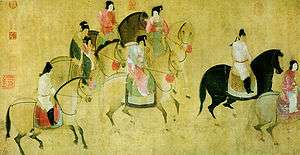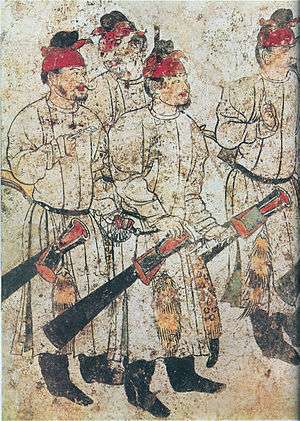Tang dynasty painting

During the Tang dynasty, as a golden age in Chinese civilization, Chinese painting developed dramatically, both in subject matter and technique. The advancements in technique and style that characterized Tang painting had a lasting influence in the art of other countries, especially in East Asia (Korea, Japan, Vietnam) and central Asia.
Early period


During the early Tang period, the painting style was mainly inherited from the previous Sui dynasty. In this period, the "painting of people" (人物畫) developed greatly. Buddhist painting and "court painting" played a major role, including paintings of the Buddha, monks, nobles etc.
One of the first landscape murals is located in Han Xiu's tomb.[1]
Brothers Yan Liben (閻立本) and Yan Lide (閻立德) were among the most prolific painters of this period. Yan Liben was the personal portraitist to the Emperor Taizong, and his most notable works include the Thirteen Emperors Scroll (歷代帝王圖).
Mid and Late period
The landscape (shan shui) painting technique developed quickly in this period and reached its first maturation. Li Sixun (李思訓) and Li Zhaodao (李昭道) (father and son) were the most famous painters in this domain.
The painting of people also reached a climax. The outstanding master in this field is Wu Daozi (吳道子), who is referred to as the "Sage of Painting". Wu's works include God Sending a Son (天王送子圖). Wu created a new technique of drawing named "Drawing of Water Shield" (蒓菜描).
The great poet Wang Wei (王維) first created the brush and ink painting of shan-shui, literally "mountains and waters" (水墨山水畫). He further combined literature, especially poetry, with painting. The use of line in painting became much more calligraphic than in the early period.
The theory of painting also developed, and Buddhism, Taoism, and traditional literature were absorbed and combined into painting. Paintings on architectural structures, such as murals (壁畫), ceiling paintings, cave paintings, and tomb paintings, were very popular. An example is the paintings in the Mogao Caves in Xinjiang during this period.
Influence
Tang painting had a major influence on East Asian painting and central Asia painting.
See also
References
- ↑ "Earliest landscape mural of Tang Dynasty unearthed". Shaanxi Provincial Bureau of Cultural Heritage. Retrieved 27 July 2015.
- Eichenbaum, Patricia. Arts of the Tang Court. New York: Oxford University Press, 1996.
- Loehr, Max. The Great Painters of China. New York: Harper & Row, 1980.